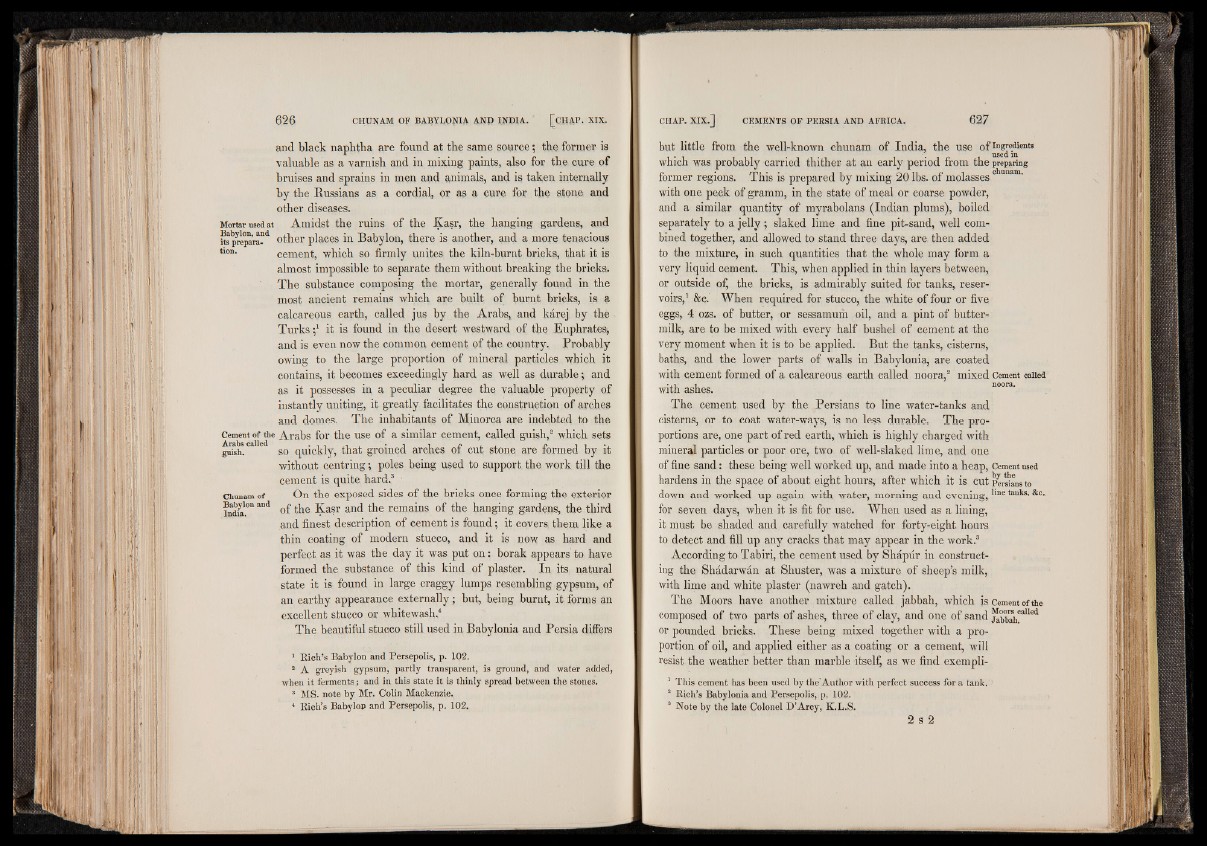
and black naphtha are found at the same source; the former is
valuable as a varnish and in mixing paints, also for the cure of
bruises and sprains in men and animals, and is taken internally
by the Russians as a cordial, or as a cure fop the stone and
other diseases.
Mortar used at Amidst the ruins of the Kasr, the hanging gardens, and
its prepara- other places in Babylon, there is another, and a more tenacious
tlon- cement, which so firmly unites the kiln-burnt bricks, that it is
almost impossible to separate them without breaking the bricks.
The substance composing the mortar, generally found in the
most ancient remains which are built of burnt bricks, is a
calcareous earth, called jus by the Arabs, and karej by the
Turks it is found in the desert westward of the Euphrates,
and is even now the common cement of the country. Probably
owing to the large proportion of mineral particles which it
contains, it becomes exceedingly hard as well as durable; and
as it possesses in a peculiar degree the valuable property of
instantly uniting, it greatly facilitates the construction of arches
and domes. The inhabitants of Minorca are indebted to the
Cement of the Arabs for the use of a similar cement, called guish,2 which sets
guish. so quickly, that groined arches of cut stone are formed by it
without centring; poles being used to support the work till the
cement is quite hard.3 '
Chunam of On the exposed sides of the bricks once forming the exterior
Indra.0n and °f the Kasr and the remains of the hanging gardens, the third
and finest description of cement is found; it covers them like a
thin coating of modern stucco, and it is now as hard and
perfect as it was the day it was put on: borak appears' to have
formed the substance of this kind of plaster. In its, natural
state it is found in large craggy lumps resembling gypsum, of
an earthy appearance externally; but, being burnt, it forms an
excellent stucco or whitewash,4
The beautiful stucco still used in Babylonia and Persia differs
’ Rich’s Babylon and Persepolis, p. 102.
* A greyish gypsum, partly transparent, is ground, and water added,
when it ferments; and in this state it is thinly spread between the stones.
3 MS. note by Mr. Colin Mackenzie.
4 Rich’s Babylon and Persepolis, p. 102.
but little from the well-known chunam of India, the use of ingredients
which was probably carried thither, at an early period from the preparing
former regions. This is prepared by mixing 20 lbs. of molasses
with one peck of gramm, in the state of meal or coarse powder,
and a similar quantity of myrabolans (Indian plums), boiled
separately to a jelly; slaked lime and fine pit-sand, well combined
together, and allowed to stand three days, are then added
to the mixture, in such quantities that the whole may form a
very liquid cement. This, when applied in thin layers between,
or outside of, the bricks, is admirably suited for tanks, reservoirs,
1 &c. When required for stucco, the white of four or five
eggs,, 4 ozs. of butter, or sessamum oil, and a pint of buttermilk,
are to be mixed with every half bushel of cement at the
very moment when it is to be applied. But the tanks, cisterns,
baths, and the lower parts of walls in Babylonia, are coated
with cement formed of a calcareous earth called noora,2 mixed Cement called
with asih es. noora.
The cement used by the Persians to line water-tanks and
cisterns, or to coat water-ways, is no less durable. The proportions
are, one part of red earth, which is highly charged with
mineral particles or poor ore, two of well-slaked lime, and one
of fine sand: these being well worked up, and made into a heap, Cement used
hardens in the space of about eight hours, after which it is cut Persians to
down and worked up again with water, morning and evening, tauks’&Ci
for seven days, when it is fit for use. When used as a lining,
it must be shaded and carefully watched for forty-eight hours
to detect and fill up any cracks that may appear in the work.3
According to Tabiri, the cement used by Shapur in constructing
the Shadarwan at Shuster, was a mixture of sheep’s milk,
with lime and white plaster (nawreh and gatch).
The Moors have another mixture called jabbah, which is Cement of the
composed of two parts of ashes, three of clay, and one of sand jabbah?alled
or pounded bricks. These being mixed together with a proportion
of oil, and applied either as a coating or a cement, will
resist the weather better than marble itself, as we find exempli-
1 This cement has been used by the’Author with perfect success for a tank. '
2 Rich’s Babylonia and Persepolis, p. 102.
3 Note by the late Colonel D’Arcy, K.L.S.
2 s 2